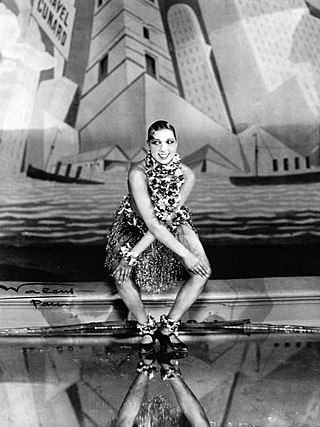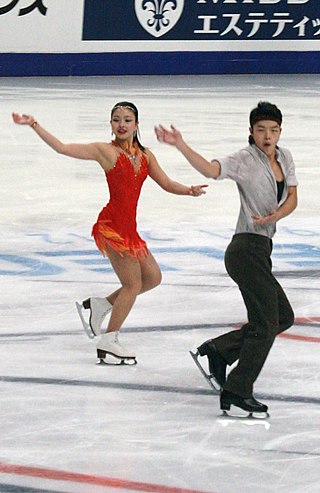Related Research Articles
An alphabetic list of modern country dance terminology:

The Charleston is a dance named after the harbor city of Charleston, South Carolina. The rhythm was popularized in mainstream dance music in the United States by a 1923 tune called "The Charleston" by composer/pianist James P. Johnson, which originated in the Broadway show Runnin' Wild and became one of the most popular hits of the decade. Runnin' Wild ran from 28 October 1923 through 28 June 1924. The Charleston dance's peak popularity occurred from mid-1926 to 1927.

Scottish country dance (SCD) is the distinctively Scottish form of country dance, itself a form of social dance involving groups of couples of dancers tracing progressive patterns. A dance consists of a sequence of figures. These dances are set to musical forms which come from the Gaelic tradition of Highland Scotland, as do the steps used in performing the dances. Traditionally a figure corresponds to an eight-bar phrase of music.

Moshing is an extreme style of dancing in which participants push or slam into each other. Taking place in an area called the mosh pit, it is typically performed to aggressive styles of live music such as punk rock and heavy metal.
The polska is a family of music and dance forms shared by the Nordic countries: called polsk in Denmark, polka or polska in Estonia, polska in Sweden and Finland, and by several different names in Norway. Norwegian variants include pols, rundom, springleik, and springar. The polska is almost always seen as a partner dance in, although variants in 2
4 time, as well as in compound meters also exist.

A redowa is a dance of Czech origin with turning, leaping waltz steps that was popular in European ballrooms.

The Hokey Pokey is a participation dance with a distinctive accompanying tune and lyric structure. It is well-known in English-speaking countries. It originates in a British folk dance, with variants attested as early as 1826. The song and accompanying dance peaked in popularity as a music hall song and novelty dance in the mid-1940s in the UK. The song became a chart hit twice in the 1980s. The first UK hit was by The Snowmen, which peaked at UK No. 18 in 1981.

A cèilidh or céilí is a traditional Scottish and Irish social gathering. In its most basic form, it simply means a social visit. In contemporary usage, it usually involves dancing and playing Gaelic folk music, either at a home or a larger concert at a social hall or other community gathering place.
The Hustle is a catch-all name for some disco dances which were extremely popular in the 1970s. Late 1970s, Bump, Hustle, Watergate and Spank were popular. It mostly refers to the unique partner dance done in nightclubs to disco music. Hustle has steps in common with Mambo and Salsa and basic steps are somewhat similar to Euro dance style Discofox, which emerged at about the same time and is more familiar in various European countries. Modern partner hustle is sometimes referred to as New York hustle, however, its original name is the Latin hustle.
"Cotton-Eyed Joe" is a traditional American country folk song popular at various times throughout the United States and Canada, although today it is most commonly associated with the American South. The song is mostly identified with the 1994 Rednex version, which became popular worldwide. The song is also an instrumental banjo and bluegrass fiddle standard.
The country/western two-step, often called the Texas two-step or simply the two-step, is a country/western dance usually danced to country music in common time. "Traditional [Texas] two-step developed, my theory goes, because it is suited to fiddle and guitar music played two-four time with a firm beat [found in country music]. One-two, one-two, slide-shuffle. The two-step is related to the polka, the Texas waltz, and the jitterbug.
The Texas two-step is the same step known to ballroom dancers as the international fox-trot. Except for the one-step, which is just that, most Texas dances are variations of a two-step, also called a half-step, which is simply a step-close-step. The Texas two-step is generally done with two long steps and a step-close-step to two-four time. Speeded up, it's a shuffle or double shuffle, but still a two-step.
Bush dance is a style of dance from Australia, particularly where the music is provided by a bush band. The dances are mainly based on the traditional folk dances of the UK, Ireland and central Europe.
Contra dance choreography specifies the dance formation, the figures, and the sequence of those figures in a contra dance. The figures repeat, ideally, in a graceful flowing pattern, aligned with the phrasing of the music. Contra dance figures do not have defined footwork; within the limits of the music and the comfort of their fellow dancers, individuals move to the beat and embellish according to their own taste. Much of the dance is done as a walking movement, one step for each count of the music, while the arms and hands do most of the changing, most of these involving connecting with others' hands.
Strip the willow is a ceilidh dance. It has variations depending upon whether it is being performed as a movement in a larger dance or a complete dance in itself.
"Mairi's Wedding" is a Scottish folk song originally written in Gaelic by John Roderick Bannerman (1865–1938) for Mary C. MacNiven (1905–1997) on the occasion of her winning the gold medal at the National Mòd in 1934. In 1959, James B. Cosh devised a Scottish country dance to the tune, which is 40 bars, in reel time.
British Ice Skating is the national governing body of ice skating within the United Kingdom. Formed in 1879, it is responsible for overseeing all disciplines of ice skating: figure skating ; synchronised skating; and speed skating.
Sir Hugh Stevenson Roberton was a Scottish composer and, as founder of the Glasgow Orpheus Choir, one of Britain's leading choral-masters in the first half of the 20th century.
A step sequence is a required element in all four disciplines of figure skating, men's single skating, women's single skating, pair skating, and ice dance. Step sequences have been defined as "steps and turns in a pattern on the ice". Skaters earn the most points in step sequences by performing steps and movements with "flair and personality", by turning in both directions, by using one foot and then the other, and by including up and down movements.

Ice dance, a discipline of figure skating, has required elements that make up a well-balanced rhythm dance program and free dance program, which must be performed during competitions. They include: the dance lift, the dance spin, the step sequence, turn sequences, and choreographic elements. The elements must be performed in specific ways, as described by published communications by the International Skating Union (ISU), unless otherwise specified. The ISU has also provided a list of illegal movements.
References
- ↑ unknown. "Dance: The Dashing White Sergeant".
- ↑ Edmondstoune Duncan, Lyrics from the Old Song Books G Routledge & Sons Ltd, London 1927 (p.406)
- ↑ Flutetunes.com – Sheet Music: The Dashing White Sergeant
- 1 2 Andrew Kuntz, The Fiddler’s Companion: A Descriptive Index of North American, British Isles and Irish Music for the Folk Violin and other Instruments – Alphabetical Files: DASH–DAY
- ↑ Europe, Empire And Spectacle in Nineteenth-Century British Music by Rachel Cowgill and Julian Rushton, Ashgate Publishing 2006 (p. 269)]
- ↑ David Daiches, The New companion to Scottish culture, Polygon 1993 (p.74)
- ↑ Scottish Country Dancing Dictionary – Scottish Country Dance Instruction – The Dashing White Sergeant